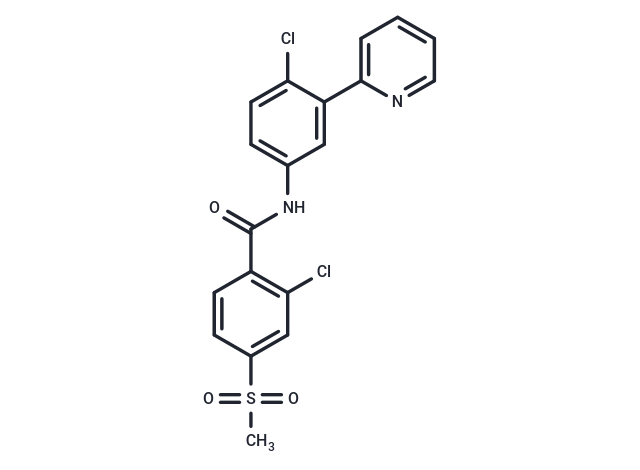Shopping Cart
- Remove All
 Your shopping cart is currently empty
Your shopping cart is currently empty


| Pack Size | Price | Availability | Quantity |
|---|---|---|---|
| 5 mg | $38 | In Stock | |
| 10 mg | $53 | In Stock | |
| 50 mg | $67 | In Stock | |
| 100 mg | $85 | In Stock | |
| 200 mg | $110 | In Stock | |
| 1 mL x 10 mM (in DMSO) | $57 | In Stock |
| Description | Vismodegib (GDC-0449) is a hedgehog pathway inhibitor (IC50: 3 nM). It also inhibits P-gp (IC50: 3.0 μM), ABCG2 (IC50: 1.4 μM). |
| Targets&IC50 | Hedgehog:3 nM (cell free), P-gp:3.0 μM, ABCG2:1.4 μM |
| In vitro | Vismodegib (GDC-0449) is a potent inhibitor of two ABC transporters, ABCG2/BCRP and ABCB1/Pgp, and is a mild inhibitor of ABCC1/MRP1. In ABCG2-overexpressing HEK293 cells, Vismodegib increased retention of the fluorescent ABCG2 substrate BODIPY-prazosin and resensitized these cells to mitoxantrone, an antineoplastic ABCG2 substrate. Vismodegib also resensitized human non-small cell lung carcinoma cells NCI-H460/par and NCI-H460/MX20, which overexpress ABCG2 in response to mitoxantrone, to mitoxantrone, and to topotecan or SN-38. The IC(50) values of Vismodegib for inhibition of ABCG2 and Pgp were approximately 1.4 and approximately 3.0 μM, respectively [2]. GDC-0449 inhibited cell growth in cisplatin-na?ve and -resistant cells. In both cell types, GDC-0449 increased [Ca(2+)](cyto) and reduced endoplasmatic [Ca(2+)](ER) [3]. |
| In vivo | Oral dosing of vismodegib caused tumor regressions in the Ptch(+/-) allograft model of medulloblastoma at doses ≥25 mg/kg and tumor growth inhibition at doses up to 92 mg/kg dosed twice daily in two ligand-dependent CRC models, D5123, and 1040830. Analysis of Hh pathway activity and PK/PD modeling reveals that vismodegib inhibits Gli1 with a similar IC(50) in both the medulloblastoma and D5123 models (0.165 μmol/L ±11.5% and 0.267 μmol/L ±4.83%, respectively). Pathway modulation was linked to efficacy using an integrated PK/PD model revealing a steep relationship where > 50% of the activity of vismodegib is associated with >80% repression of the Hh pathway [4]. |
| Cell Research | MDCKII cells were plated into 24-well plates at a density of 3 x 10^5 cells per well and were allowed to attach. The medium was then changed to that containing different drugs (50 μM VP, 50 μM indomethacin, or 20 μM Vismodegib) in DMSO or DMSO alone as control, and nonfluorescent calcein-AM was added to a final concentration of 1.0 μM and incubated at 37°C for 2 hours. Cells were then washed twice with Ca2+, Mg2+-containing Hank's balanced salt solution buffer and lysed by shaking in 0.01% Triton X-100 in PBS buffer for 1 hour at room temperature or overnight at 4°C. The lysate was then transferred into 96-well plates, and the fluorescence signal caused by the cell-derived calcein was quantified spectrophotometrically with a SpectraMax M5 Multi-Detection Reader using an excitation wavelength of 495 nm and an emission wavelength of 515 nm. All manipulations were performed in the dark. All readings are expressed as mean ± SEM normalized to the control [2]. |
| Animal Research | Female CD-1 nude mice (weighing 25–28 g) were administered oral doses of 5, 15, 50, and 100 mg/kg (free base equivalent) of vismodegib hydrochloride salt in 0.5% methylcellulose/0.2% Tween 80 (MCT). Blood samples (~1 mL) were collected up to 24 hours postdose via cardiac puncture (terminal collection) into tubes containing potassium ethylenediaminetetraacetic acid (K2EDTA) anticoagulant. Immediately on the collection, the blood was mixed with K2EDTA and stored on ice. Within 30 minutes, blood samples were centrifuged at approximately 1000 to 1500 × g for 5 minutes at 4°C, and plasma was harvested. The plasma samples were stored at ?80°C until analysis. Concentrations of vismodegib were determined by LC/MS/MS as described previously [4]. |
| Alias | Erivedge, GDC-0449, RG 3616 |
| Molecular Weight | 421.3 |
| Formula | C19H14Cl2N2O3S |
| Cas No. | 879085-55-9 |
| Storage | Powder: -20°C for 3 years | In solvent: -80°C for 1 year | Shipping with blue ice. | |||||||||||||||||||||||||||||||||||
| Solubility Information | DMSO: 50 mg/mL (118.68 mM) Ethanol: Insoluble H2O: Insoluble | |||||||||||||||||||||||||||||||||||
Solution Preparation Table | ||||||||||||||||||||||||||||||||||||
DMSO
| ||||||||||||||||||||||||||||||||||||

Copyright © 2015-2024 TargetMol Chemicals Inc. All Rights Reserved.